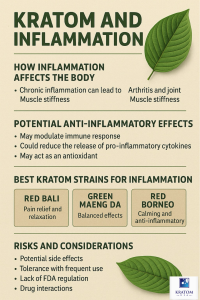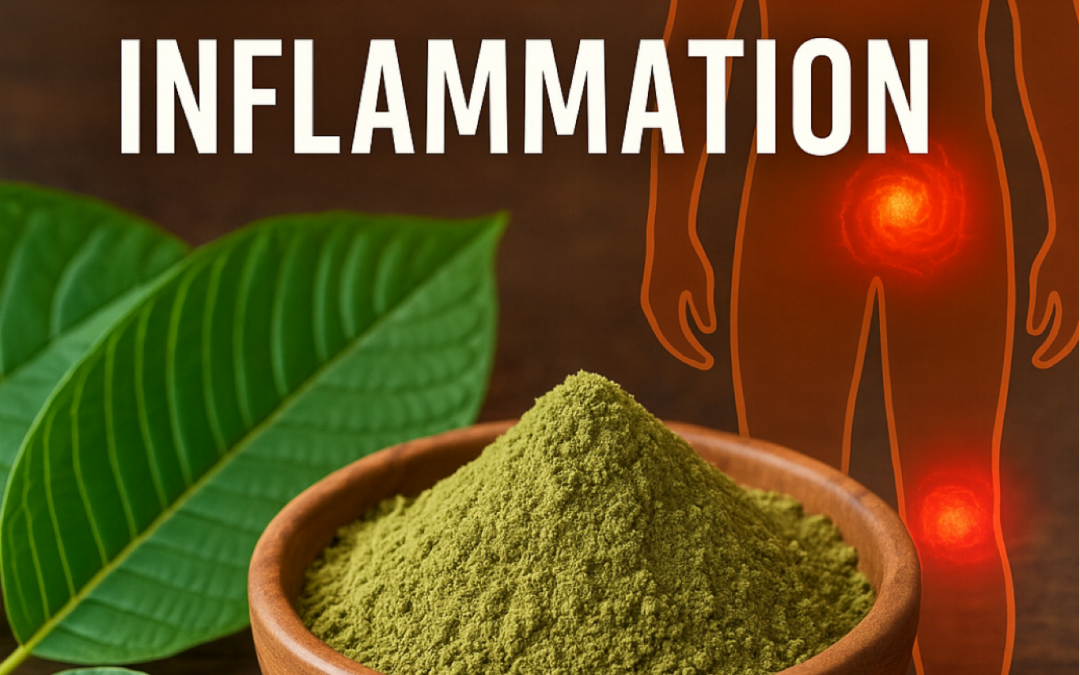🌿 Kratom and Inflammation: Can This Natural Remedy Soothe Your Pain?
Exploring the Anti-Inflammatory Potential of Kratom’s Alkaloids
Inflammation is at the root of many chronic health issues—from arthritis and joint pain to autoimmune disorders and muscle soreness. As more people look for alternatives to NSAIDs and prescription painkillers, kratom has emerged as a promising natural remedy. But how effective is kratom for inflammation, really? In this article, we explore the science behind kratom and inflammation, how its alkaloids may reduce pain and swelling, and which strains are best for anti-inflammatory support. Whether you’re managing chronic pain or exploring natural wellness, this guide will help you make an informed choice.
📌 Key Points: Kratom and Inflammation
-
🔬 Kratom contains alkaloids like mitragynine and speciogynine that may reduce inflammation
-
🧠 These compounds act on mu-opioid and adrenergic receptors, modulating pain and immune response
-
💊 Users report relief from arthritis, joint pain, and post-exercise inflammation
-
🌿 Red and green vein kratom strains are most commonly used for anti-inflammatory effects
-
⚠️ Kratom is not a substitute for medical treatment—moderation and product quality matter
🌱 What Is Kratom? A Quick Overview
 Kratom (Mitragyna speciosa) is a tropical evergreen tree native to Southeast Asia. Traditionally used for its stimulant and pain-relieving properties, kratom leaves are rich in bioactive alkaloids, including:
Kratom (Mitragyna speciosa) is a tropical evergreen tree native to Southeast Asia. Traditionally used for its stimulant and pain-relieving properties, kratom leaves are rich in bioactive alkaloids, including:
-
Mitragynine – the most abundant alkaloid, with analgesic and anti-inflammatory properties
-
7-hydroxymitragynine – a powerful pain reliever, active at lower concentrations
-
Speciogynine & Paynantheine – believed to aid in muscle relaxation and inflammation support
🔥 What Is Inflammation and Why Does It Matter?
Inflammation is the body’s response to injury, infection, or stress. While acute inflammation is necessary for healing, chronic inflammation can cause long-term damage and contribute to:
-
Arthritis and joint pain
-
Muscle stiffness
-
Autoimmune conditions
-
Digestive disorders
-
Cardiovascular disease
Reducing inflammation can help improve mobility, reduce pain, and enhance overall wellness.
🧪 How Kratom Interacts with the Body’s Inflammatory Pathways
Kratom’s effects come from its unique interaction with the nervous and immune systems. Studies suggest kratom’s alkaloids may:
-
Modulate immune response by interacting with opioid and adrenergic receptors
-
Reduce the release of pro-inflammatory cytokines, which are chemical messengers that trigger swelling and pain
-
Act as antioxidants, neutralizing free radicals that contribute to inflammation
🧬 A 2014 study in the Asian Pacific Journal of Tropical Biomedicine found that kratom leaf extracts had dose-dependent anti-inflammatory effects in animal models.
💬 Real-World Experiences: Kratom for Pain and Inflammation
Many users report significant relief from inflammatory pain, including:
“I’ve dealt with rheumatoid arthritis for over 10 years. Kratom gives me the same level of relief as prescription anti-inflammatories—without the stomach issues.”
– Kimberly, 54, KratomUSA.com customer
“After workouts, I used to take ibuprofen for soreness. Now I make a kratom tea with Red Bali, and the inflammation goes down within an hour.”
– Carlos, 38, fitness coach
🍃 Best Kratom Strains for Inflammation Support
1. 🔴 Red Bali
-
Known for pain relief and deep relaxation
-
Ideal for nighttime use or chronic inflammatory conditions
2. 🟢 Green Maeng Da
-
Offers a balance of energy and pain relief
-
Great for daytime inflammation management without sedation
3. 🔴 Red Borneo
-
Calming and anti-inflammatory
-
Popular among users with arthritis and autoimmune pain
📏 Kratom Dosage for Inflammation
| Experience Level | Recommended Dose |
|---|---|
| Beginner | 1.5 – 2.5 grams |
| Moderate | 2.5 – 4 grams |
| Experienced | 4 – 6 grams (use caution) |
✅ Always start low and work your way up. Higher doses can lead to sedation or side effects.
⚠️ Risks and Considerations
While kratom may offer natural inflammation support, it’s not risk-free. Be aware of:
-
Potential side effects: nausea, dizziness, constipation
-
Tolerance or dependence with high, frequent use
-
Lack of FDA regulation—choose only lab-tested kratom from trusted vendors
-
Drug interactions—consult your doctor if taking prescriptions or managing a chronic condition
🛒 Where to Buy Kratom for Inflammation Relief
For safe and effective use, buy kratom from a vendor that offers:
-
✅ Third-party lab testing
-
✅ Clear strain labeling
-
✅ Verified customer reviews
-
✅ Transparent sourcing
🛍️ Check out Kratom USA for Red Bali, Green Maeng Da, and other premium strains backed by purity testing and fast shipping.
❓ FAQ: Kratom and Inflammation
Does kratom reduce inflammation?
Yes, kratom contains alkaloids that may reduce inflammation by modulating immune response and acting on pain receptors.
Which kratom strain is best for inflammation?
Red Bali and Green Maeng Da are top choices for managing inflammation and related pain.
Is kratom safer than NSAIDs?
Kratom may offer relief without the GI side effects of NSAIDs, but it has its own risks. Always use responsibly.
How long does it take kratom to work for inflammation?
Effects are typically felt within 30–45 minutes, depending on strain, dose, and method of use.
Can I take kratom daily for inflammation?
Yes, but it’s best to rotate strains and take regular breaks to prevent tolerance and maintain effectiveness.
🌿 Final Thoughts: Can Kratom Help with Inflammation?
Kratom shows real promise as a natural alternative to over-the-counter anti-inflammatories—especially for people seeking relief from chronic pain, arthritis, or exercise-related soreness.
Its alkaloids may not only reduce pain but also modulate inflammatory pathways, helping your body find balance naturally. Still, kratom isn’t a silver bullet. Responsible use, proper sourcing, and informed decisions are key to using it safely and effectively.
Ready to try kratom for inflammation relief? Visit Kratom USA to explore lab-tested strains trusted by thousands.


